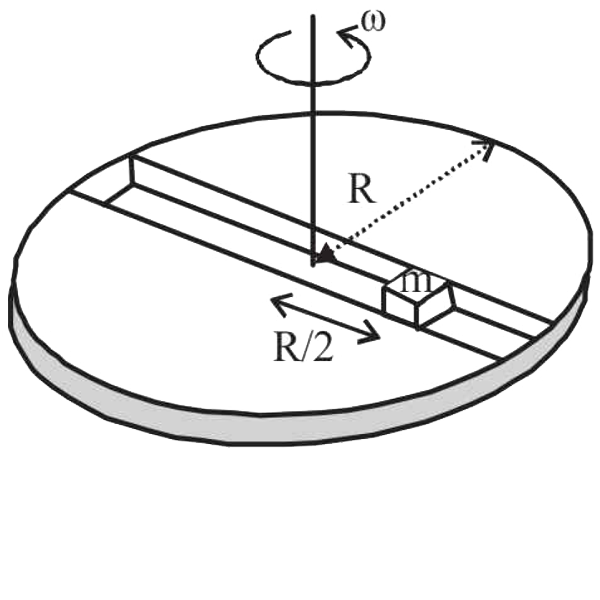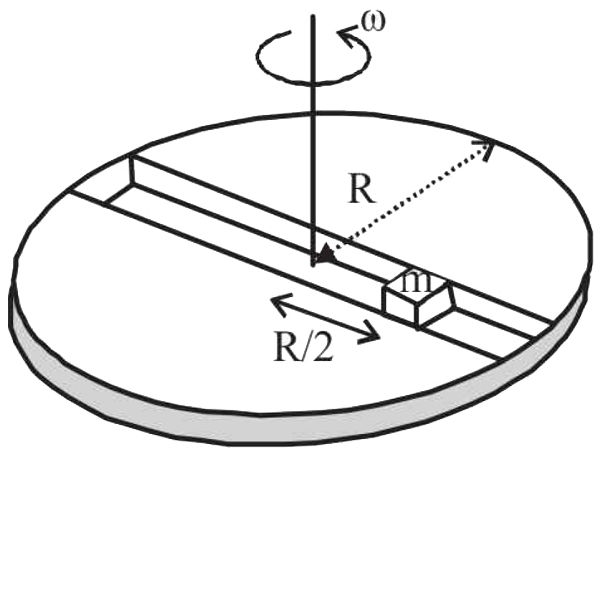Complete Solutions to Comprehension type of chapter FRICTION AND CIRCULAR MOTION of Class 11 book with complete answers and questions
| Class 11 | PHYSICS |
| Chapter | FRICTION AND CIRCULAR MOTION |
| GRB PUBLICATION | Comprehension type |
| Number Of Questions | 11 |
| Academic Year | 2023-24 |

When F = 2 N , the frictional force between 5 kg block and ground is :View Solution
The acceleration of 10 kg block when F = 30 N ,View Solution
Find the minimum value of F for which 5 kg being to slide if the coefficient of friction between the blocks is changed to `0.5` :View SolutionTwo bodies A and B of masses 10 kg and 5 kg are placed very slightly separated as shown in figure . The coefficient of friction between the floor and the blocks are `mu_(s) = mu_(k) = 0.4` . Block A is pushed by an external force F . The value of F can be changed . When the welding between block A and ground breaks , block A will start pressing block B and when welding of B also breaks , block B will start pressing the vertical wall .

If F = 20 N , with how much force does block A presses the block B ?View SolutionTwo bodies A and B of masses 10 kg and 5 kg are placed very slightly separated as shown in figure . The coefficient of friction between the floor and the blocks are `mu_(s) = mu_(k) = 0.4` . Block A is pushed by an external force F . The value of F can be changed . When the welding between block A and ground breaks , block A will start pressing block B and when welding of B also breaks , block B will start pressing the vertical wall .

If F = 50 N , the friction force acting between block B and ground will be :View SolutionTwo bodies A and B of masses 10 kg and 5 kg are placed very slightly separated as shown in figure . The coefficient of friction between the floor and the blocks are `mu_(s) = mu_(k) = 0.4` . Block A is pushed by an external force F . The value of F can be changed . When the welding between block A and ground breaks , block A will start pressing block B and when welding of B also breaks , block B will start pressing the vertical wall .

The force of friction acting on B varies with the applied force F according to curve :View SolutionA block of mass M slides on a frictionless surface with an initial speed of `v_(0)` . On top of block is small box of mass m . The coefficient of friction between box and block are `mu_(s)` and `mu_(k)` . The sliding block encounters an ideal spring with force constant k . Answer the following questions :

Assuming no relative motion between box and block what is the maximum possible acceleration of block and box at the instant of maximum compression ?View SolutionA block of mass M slides on a frictionless surface with an initial speed of `v_(0)` . On top of block is small box of mass m . The coefficient of friction between box and block are `mu_(s)` and `mu_(k)` . The sliding block encounters an ideal spring with force constant k . Answer the following questions :

What is maximum value of k for which it remains true that box does not slide ?View SolutionA block of mass M slides on a frictionless surface with an initial speed of `v_(0)` . On top of block is small box of mass m . The coefficient of friction between box and block are `mu_(s)` and `mu_(k)` . The sliding block encounters an ideal spring with force constant k . Answer the following questions :

Suppose the value of k is just slightly greater than the value found in Q.2 , so that the box begins to slide just as the spring reaches maximum compression . The accelerations of box and block are respectively :View SolutionA frame of reference that is accelerated with respect to an inertial frame of reference is called a non-inertial frame of reference. A coordinate system fixed on a circular disc rotating about a fixed axis with a constant angular velocity `omega` is an example of non=inertial frame of reference. The relationship between the force `vecF_(rot)` experienced by a particle of mass m moving on the rotating disc and the force `vecF_(in)` experienced by the particle in an inertial frame of reference is
`vecF_(rot)=vecF_(i n)+2m(vecv_(rot)xxvec omega)+m(vec omegaxx vec r)xxvec omega`.
where `vecv_(rot)` is the velocity of the particle in the rotating frame of reference and `vecr` is the position vector of the particle with respect to the centre of the disc.
Now consider a smooth slot along a diameter fo a disc of radius R rotating counter-clockwise with a constant angular speed `omega` about its vertical axis through its center. We assign a coordinate system with the origin at the center of the disc, the x-axis along the slot, the y-axis perpendicular to the slot and the z-axis along the rotation axis `(vecomega=omegahatk)`. A small block of mass m is gently placed in the slot at `vecr(R//2)hati` at `t=0` and is constrained to move only along the slot.

The distance r of the block at time is20:36View SolutionA frame of reference that is accelerated with respect to an inertial frame of reference is called a non-inertial frame of reference. A coordinate system fixed on a circular disc rotating about a fixed axis with a constant angular velocity `omega` is an example of non=inertial frame of reference. The relationship between the force `vecF_(rot)` experienced by a particle of mass m moving on the rotating disc and the force `vecF_(in)` experienced by the particle in an inertial frame of reference is
`vecF_(rot)=vecF_(i n)+2m(vecv_(rot)xxvec omega)+m(vec omegaxx vec r)xxvec omega`.
where `vecv_(rot)` is the velocity of the particle in the rotating frame of reference and `vecr` is the position vector of the particle with respect to the centre of the disc.
Now consider a smooth slot along a diameter fo a disc of radius R rotating counter-clockwise with a constant angular speed `omega` about its vertical axis through its center. We assign a coordinate system with the origin at the center of the disc, the x-axis along the slot, the y-axis perpendicular to the slot and the z-axis along the rotation axis `(vecomega=omegahatk)`. A small block of mass m is gently placed in the slot at `vecr(R//2)hati` at `t=0` and is constrained to move only along the slot.

The net reaction of the disc on the block is20:36View Solution
Comprehension type questions and complete solutions for chapter FRICTION AND CIRCULAR MOTION of GR BATHLA & SONS PHYSICS (HINGLISH) of Class 11
